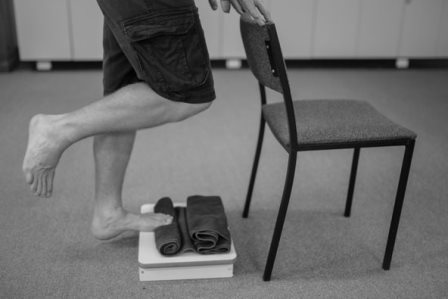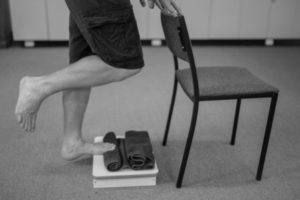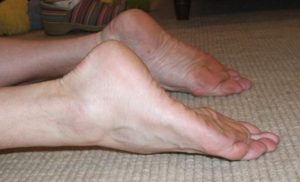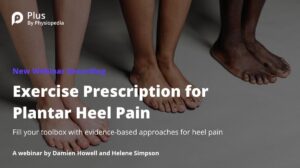Can Isometric Exercise Help Plantar Heel Pain: What is Best Joint Position?

Anyone who has had tendon pain will tell you it is a frustrating problem to resolve. Common repetitive use tendon problems include: plantar heel pain; Achilles; patellar (knee) tendon; hamstring tendon; gluteal (buttock pain) tendon; rotator cuff (shoulder) syndrome; and tennis elbow.
Tendon problems take a long time to heal. Understanding the continuum of tendon pathology and repair is a challenging complex problem which continues to have many unanswered questions.
Isometric strengthening exercise for pain reduction:
A mainstay of therapy for musculoskeletal injuries has been isometric strengthening exercises. Isometric strengthening exercises became popular in the 1920’s as a result of promotion by celebrity body builder Charles Atlas. Isometric exercises are a type of strengthening exercise in which the muscle is contracting but there is no movement of the joint. It is exerting a force with no movement. Research has shown that isometric exercise has a pain relieving effect for tendon problems. The reduced pain can be immediate and last as long as 45 minutes. The mechanism of how this pain reduction occurs is currently being investigated.
Several questions remain unanswered including:
- When is best time to use isometric strengthening exercise?
- How much force to exert?
- How frequently should isometric strengthening exercises be done?
- What is the best joint position to perform the isometric strengthening exercises?
Worse & better position to perform isometric strengthening exercise:
There is agreement on what is the worst joint position. Do not do strengthening exercises with the muscle tendon unit in a lengthened or stretched position. Tendons are subjective to tensile and compressive forces. At the interface between the tendon and the bone the deeper portion of the tendon is subjected to compressive force against the bony prominence. Excessive compressive force on tendons is considered harmful. Isometric strengthening exercises should not be performed when the muscle tendon unit is a stretched position.
This leaves two options when performing isometric strengthening exercises to position the joint where:
- The muscle tendon unit is neutral length
- In a position when the muscle tendon unit is in a position of shortest length or on slack.
My belief is if the painful muscle tendon unit also has a length associated muscle weakness commonly called a “stretch weakness”, then the isometric strengthening exercise should be performed in a position when the muscle tendon unit is at it shortest length, on slack.
A “stretch weakness” is an alteration of the normal relationship between a muscle’s length and its ability to generate force. A muscle which is longer than normal has difficulty generating force in the last 5% to 10% of the range of motion. This is analogous to a sprung spring that has become overstretched or too loose. If the muscle is the metal spring on a screen door, then stretch weakness would mean increased space between the coils of the metal spring. The metal spring will be ineffective at fully closing the screen door.
Using isometric exercise for plantar heel pain
Plantar heel pain is commonly thought to be a problem of the plantar fascia. Plantar fascia is a tissue which functions as a strong ligament. Plantar fascia does not have ability to contract, or shorten. A newer concept is the tissue source of plantar heel pain can be a tendon. The intrinsic plantar flexor muscles are deeper than the plantar fascia and attached to the calcaneus bone at the common site of plantar heel pain. Plantar heel pain maybe a tendon problem.
If plantar heel pain is a problem of the tendon of the plantar intrinsic foot muscles then the position which would compress the tendon is illustrated below. Notice the towel roll under the toes designed to stretch the plantar fascia. This is a position which compresses the intrinsic foot muscle tendon unit and is harmful.

This position is commonly recommended as appropriate treatment for plantar heel pain. M. S. Rathleff (2014) did research concluding that high- high-load strengthening (heel raise exercise) performed as illustrated above may aid in a quicker reduction in plantar heel pain compared to stretching exercises.
My opinion is this position illustrated above would compress the deep portion of the intrinsic plantar flexor muscle tendon unit, and this is not such a good thing. If the towel was removed and the subject was asked to perform isometric strengthening and or the high-load strengthening exercises as prescribed by Dr. Rathleff, it would result in better outcome.
Alternatively to performing high-load strengthening exercises (heel raise exercise) executing isometric strengthening exercises of the plantar flexor intrinsic muscles is an option. Isometric strengthening exercise performed with the muscle tendon unit in a position of slack as illustrated below is an option. This isometric strengthening exercise can be used early in the rehabilitation process and eventually progressed to the high-load heel raise exercise.

From this position flex the toes off the floor towards the ceiling in a firm isometric contraction of the intrinsic plantar flexor muscles of the foot.
Perhaps there is a better way to use strengthening exercises for management of plantar heel pain?
A on demand-video webinar exploring this topic is available at Plus by Physiopedia entitled “Exercise Prescription for Plantar Heel Pain Webinar”
Use this code – “Damien25” for a 30% discount to access this webinar as well as the more than 500 continuing education webinar courses available at Plus by Physiopedia. This is the link http://bit.ly/DAMIEN25 with the 30% discount code embedded.
Damien Howell Physical Therapy – 804-647-9499 – Fax: 866-879-8591 At-Home, At Office, At Fitness Facility, I come to you, I do home visits, or Online Damien@damienhowellpt.com

